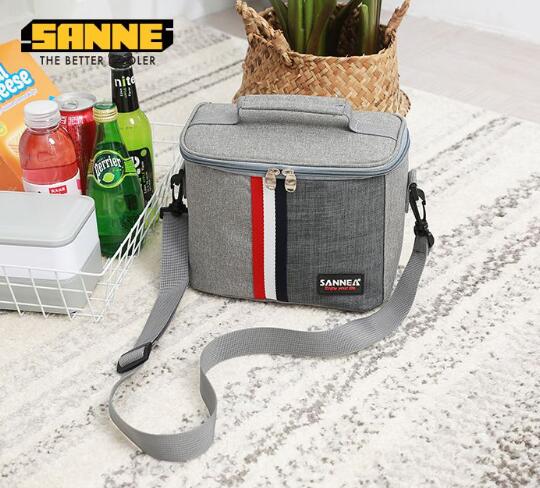Cooler bags are made from a variety of materials, including fabrics, foam, and linings. The choice of materials depends on the bag's intended use, durability, and thermal efficiency.
In the modern marketplace, insulated cooler bags are no longer a luxury but a necessity. Whether for carrying beverages, preserving food during transit, or maintaining the cold chain for sensitive products like medications, the choice of materials in cooler bags plays a crucial role in their performance. For procurement professionals, understanding the materials used in cooler bags is essential to making informed purchasing decisions. This article explores the most common materials, their advantages, and how they influence the overall quality and functionality of insulated cooler bags.

Insulated cooler bags consist of three primary layers:
Outer Layer: Often made of durable fabrics such as polyester or nylon, the outer layer provides the first line of defense against wear and tear, moisture, and external temperature fluctuations.
Inner Layer: Typically crafted from waterproof materials like PEVA (polyethylene vinyl acetate) or aluminum foil, the inner layer ensures food safety and prevents leaks.
Insulating Layer: Sandwiched between the outer and inner layers, this layer determines the bag's thermal efficiency. Common materials include foam, reflective foil, and advanced polymers designed for heat retention.
Properties: PEVA is a non-toxic, environmentally friendly alternative to PVC. It offers excellent heat retention, is lightweight, and is highly resistant to water and stains.
Applications: Widely used as the inner lining for cooler bags, especially for food-grade products.
Advantages:
Flexible and durable.
Safe for direct contact with food.
Easy to clean and maintain.
Market Insights: According to industry reports, the demand for PEVA-lined products has increased by 15% annually due to its eco-friendly reputation.
Properties: Aluminum foil is an excellent reflector of heat and is often used in conjunction with foam for added insulation.
Applications: Ideal for cooler bags requiring higher thermal efficiency, such as those used for medical supplies.
Advantages:
High thermal reflectivity.
Lightweight and cost-effective.
Resistant to moisture and odors.
Limitations: Susceptible to tearing without proper reinforcement.
Properties: EPE foam is a lightweight, closed-cell foam with excellent cushioning and thermal properties.
Applications: Commonly used as the insulating layer in cooler bags.
Advantages:
Provides excellent heat retention.
Shock-absorbent, protecting contents during transit.
Recyclable and eco-friendly.
Industry Trend: With the global push for sustainability, the use of recyclable materials like EPE foam is becoming a standard in the industry.
Properties: These synthetic fabrics are durable, resistant to abrasion, and available in various thicknesses and finishes.
Applications: Commonly used for the outer layer of cooler bags.
Advantages:
Excellent resistance to wear and tear.
Waterproof coatings can be added for enhanced protection.
Available in a wide range of colors and designs for branding purposes.
The combination of insulating foam and reflective linings significantly impacts a cooler bag’s ability to maintain temperature. For instance, bags with thicker foam layers (above 10 mm) can keep contents cold for up to 12 hours, compared to thinner insulation that lasts 4-6 hours.
Procurement professionals should look for outer materials with high denier ratings (e.g., 600D polyester) for rugged use. Nylon and polyester blends offer an excellent balance of durability and weight, making them ideal for outdoor activities and heavy-duty usage.
Materials like PEVA and EPE foam ensure that cooler bags remain lightweight while maintaining high performance. For customers requiring mobility, such as hikers or delivery services, lightweight materials are a top priority.
The global insulated cooler bag market is projected to grow at a CAGR of 6.2% between 2023 and 2028, driven by advancements in material technology and increasing demand for eco-friendly products. Key trends include:
Biodegradable and Recycled Materials: Manufacturers are integrating recycled plastics and plant-based materials to meet environmental standards.
Antimicrobial Coatings: Inner linings with antimicrobial properties are gaining popularity for food safety applications.
Enhanced Thermal Gel Packs: Some cooler bags now include advanced gel packs integrated with the bag’s insulation for superior cooling performance.
When choosing cooler bags, consider the following factors:
End-Use Applications: Determine whether the bags will be used for food, beverages, medical supplies, or other purposes.
Branding Potential: Opt for outer materials that support high-quality logo printing for promotional use.
Budget: While premium materials like nylon and advanced foams offer superior performance, they come at a higher cost. Balance cost with functionality based on your target market.
The materials used in insulated cooler bags are the cornerstone of their performance, durability, and appeal. By understanding the properties and applications of materials like PEVA, aluminum foil, and EPE foam, procurement professionals can select products that align with their business needs.
As the market evolves, focusing on sustainable and innovative materials will not only meet customer expectations but also position your business as a forward-thinking player in the industry. If you're looking for premium-quality cooler bags with customizable features, partnering with SANNE, an experienced manufacturer, is your best step forward.
Copyright © Jinhua SANNE Household Products Co., Ltd. All Rights Reserved |
Sitemap
| Powered by
